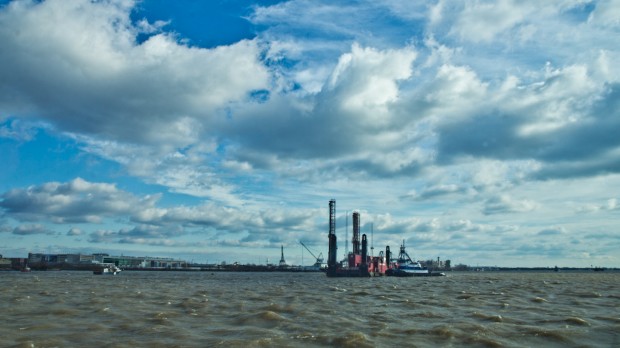Delaware basin program measures its progress in protecting water supplies
-
Jon Hurdle
The Delaware River Watershed Initiative, a wide-ranging collaboration between environmental groups seeking to protect water quality in the 13,500 square-mile area, is beginning to monitor and measure its progress since being launched in 2014.
The initiative, led by the William Penn Foundation, aims to shield the basin’s water supplies from forest loss, runoff from farms and storm drains, and aquifer depletion. It has spent the last two and a half years providing grants and coordinating the efforts of more than 40 conservation nonprofits. (William Penn also funds StateImpact).
Now, the 10-year program is moving into a second phase in which it will assess progress toward its goal of restoring clean water across the watershed from upstate New York to the mouth of the Delaware Bay.
“We need to prove to our board that this is working,” said Clare Billott, program officer for the DRWI, speaking at the biennial Delaware Estuary Science and Environmental Summit, a gathering of conservation groups brought together by the Partnership for the Delaware Estuary.
With the foundation’s initial investment of $35 million, the program is a major effort to protect water in a region that supplies drinking water to some 15 million people. DRWI officials said the program would complement the new federal Delaware River Basin Conservation Act, which requires the U.S. Fish & Wildlife Service to coordinate the work of conservation groups in the region.
Billott said the foundation has provided $15 million a year since the initiative began, and has leveraged another $15 million from the U.S. Department of Agriculture and $60 million from other sources.
While the funding may not yet have produced improvements in water quality throughout the watershed, it has helped to improve some local conditions, and has created an alliance of conservation groups that are jointly working toward common goals, Billott said.
“The biggest single thing that we got out of Phase 1 is that every one of these groups say that they are working with others,” she said.
In its upcoming second phase, the initiative’s managers will look at what participating groups have achieved but they won’t be expected to have already hit their targets, Billott said.
“Showing progress toward the goal is sufficient,” she said. “That’s good enough for us for the money we are investing.”
Phase 2 of the DRWI will consist of action plans over a three-year period that will guide strategic action on the ground in eight regional “clusters” by participating organizations.
They include the Tookany/Tacony-Frankford Watershed Partnership, a Philadelphia-based nonprofit which uses DRWI funding and technical support to help train volunteers to monitor the creek that flows through its watershed.
“We engage our upstream communities in citizen science creek monitoring,” said Robin Irizarry, the group’s Philadelphia Watershed Coordinator. “We work with citizens from our community who are interested in paying attention to their creek.”
The volunteers take samples, record their findings, and watch for changing conditions that may indicate new sources of contamination,” Irizarry said.
“As a small organization, we can’t just keep an eye on everything but having people engaged and around the creek really helps to notice if anything is changing,” he said in an interview.
DRWI helped train the volunteers, and made them aware of what the condition of their local creek means for their own community and for the Delaware Watershed as a whole, he said.
In Delaware, the watershed initiative works with the University of Delaware’s Water Resources Center to bring together local groups to monitor water quality in the Brandywine-Christina watershed.
Andrew Homsey, GIS manager for the center, said that collaboration with those groups has been a benefit of being in the partnership.
“One of the big strengths that we found was establishing partnerships with other watershed groups,” Homsey said. “We’ve established a good framework for moving forward with this larger partnership.”
Martha Narvaez, a policy scientist with the Delaware group, said the initiative has received about $300,000 from the initiative so far, and that has allowed it to move forward with projects that were previously out of its reach.
While it’s not yet clear whether the initiative has produced cleaner water in the main Delaware River or the Delaware Bay, there are signs of progress in smaller streams, Homsey said.
“Where you see the most progress is in local small streams,” he said. “If you look at macro invertebrates, the little critters that live in the stream, they are improving on the local level.
“So the big question is, when you put these puzzle pieces together, and really hit the problem areas, whether that moves the needle down at Wilmington where 600,000 people get their water, or at the Newark water treatment plant,” Homsey said.
The program’s approach to solving specific local problems is also seen in New Jersey where the American Littoral Society is encouraging communities in Bridgeton to use less water and so reduce demand on the Kirkwood Cohansey aquifer – the focus of one of the eight “clusters” set up by the initiative.
“There’s over-consumption so we’re trying to educate residents about water conservation, how to protect the aquifer by reducing demand,” said Meredith Brown, Conservation Coordinator for the organization.
The program gives ALS the capacity to meet its goals as a member of the Kirkwood-Cohansey group by offering expert advice and putting it in touch with other partners who offer ideas and support, Brown said.
With the help of the program, ALS has so far installed nine rain gardens, 40 rain barrels, and four planter boxes in downtown Bridgeton.
“We’ve been able to establish some really good relationships in the community, “ Brown said. “We’ve been able to get the storm-water infrastructure work out into the community, and make it accessible for folks so that they can learn to protect the environment.”
*William Penn Foundation provides funding to WHYY and StateImpact Pennsylvania to report on watershed issues.

















